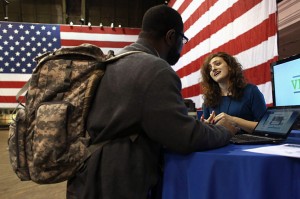
Is Enough Being Done to Prepare Veterans for Civilian Jobs?
Holly Mosack intended to go into the Army Reserve once she graduated from Northwestern University in 1997. A Reserve Officers’ Training Corps scholarship helped pay Mosack’s way through college, but a three-week stint at the U.S. Army Airborne School between her junior and senior years changed her course.
“While it was only three weeks, that’s just where I fell in love with the Army and the people,” says Mosack, who after her senior year was commissioned as an officer in the Army. “Just being around the soldiers is what I love.”
Fast-forward to 2004. Mosack had just concluded a seven-year military career and was in the process of what many veterans describe as the daunting transition into the civilian labor force.
“That transition was very difficult. My life was the military. The people I knew were the military,” Mosack says. “While I knew I had some credentials – I went to Northwestern, a great school – I didn’t have the confidence. What can I do in this civilian world? I got this degree in journalism several years ago. I don’t think I want to go into that. What am I going to do?”
Many veterans ask that very same question upon entering the civilian world. The Labor Department on Wednesday estimated 21.2 million veterans were living in the U.S. at the end of 2014, making up about 9 percent of the civilian noninstitutional population – those who are not on active military duty or in mental health facilities or jails – at least 18 years of age.
And while the military has some programs in place to help with reacclimation, the career counselors and guidance afforded to the average college student as they shape the rest of their lives far exceeds the help many veterans of the same age receive, especially if their military skill sets don’t translate well into the civilian labor force. Many veterans need to fend for themselves to get a job while adjusting to life back home.
“They do have a transition process. Every service member goes through this – how to write a resume and whatnot,” says Mosack, who is now a director of employee communications at Advanced Technology Services, a company that specializes in improving workplace productivity, particularly in the manufacturing sector.
“But you’re so used to, when you’re in the military, those processes. When you go to the doctor, you don’t have a copay. You don’t have to do anything,” she says. “You’re kind of catered to, and when it comes time to find a job, people are expecting that same help, and it’s not there. And I think that sends a lot of veterans into a world of panic once they’re getting out.”
The unemployment rate for veterans at the end of 2014 stood at 5.3 percent, down from 6.6 percent the prior year and lower than the year’s national unemployment rate of 6.2 percent. But a further breakdown of this number shows that among veterans who have served since September 2001, 7.2 percent are unemployed – down from 9 percent in 2013.
Young veterans seem to have the hardest time landing a job immediately after their return from service, as about 16.2 percent of veterans in the labor force between 18 and 24 years old are jobless. But the figures can be misleading.
“The number of veterans within that age group is, as a percentage, significantly lower, and the reason for that is most people join the military at age 18,” says Andrew Schwartz, program manager at Virginia Values Veterans, a program through the Virginia Department of Veterans Services that helps connect employers to veterans looking for work. “Most people get out of the military, if they get out after their first term, at age 22. All of a sudden, your veteran population isn’t 18 to 24. It’s 22 to 24.”
Schwartz says the small sample size in this particular group of veterans inherently creates volatility and statistical unreliability in unemployment figures.
“The Bureau of Labor Statistics can never really truly give you a good percentage of unemployment – whether it’s high, whether it’s low – because you have some holes in how that’s captured,” says Steve Gonzalez, an assistant director of the Veterans Employment and Education Division at the American Legion, noting that the figure also doesn’t count some reservists and could include veterans in school who are collecting unemployment. “You have to take it somewhat with a grain of salt, but it’s better to have something that you can kind of work off of with the hopes that you’re still doing the right things to make positive impacts than to have nothing at all.”
Gonzalez says the military offers extensive training for certain high-skills roles like electrical engineering, but that the terminology and processes used in the military aren’t always a “one-to-one direct correlation” to what would be common in a comparable civilian role.
Read the full article here.





Leave a Reply